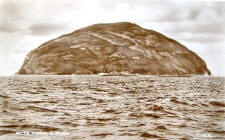|
THE stupendous insulated rock of Ailsa, between the shores
of Ayrshire and Cantyre in Argyllshire, is about eight miles from the
nearest point of the Ayrshire coast, and is generally considered as
belonging to the parish of Dailly, as it is included in the Barony of
Knockgerran, which is the property of the Earl of Cassillis, now Marquis
of Ailsa. This huge mass, probably two miles in circumference at the
base, and rising to a height variously stated at 1140, 1100, and 1008 feet
above the level of the sea, is of a conical appearance when seen from
the north or south, and the summit is covered with heath and grass. Ailsa
is precipitous on all sides, and is only accessible on the east or
south-east, at a small beach formed by the accumulation of debris. The
cliffs in many places are columnar, and the western side rises
perpendicularly from the ocean. Ailsa occupies the same position at the
entrance to the Frith of Clyde from the Atlantic as does the Bass at the
entrance to the Frith of Forth from the German Ocean, both appearing like
vast solitary sentinels, or memorials of a former world, rising abruptly
from the deep, and displaying their immense forms as if to show the
wonderful operations of nature.
 Ailsa, sometimes designated the "Perch of Clyde," is a
remarkable object at sea.
It is visible from an extraordinary distance,
and appears as if defying the billows which have dashed against its dark
sides thousands of years. A close inspection and examination increase
the awe felt by the sight of this summit of an extraordinary submarine
mountain. The world contains many remarkable objects which cannot be
adequately described, and Ailsa, like the Bass, Skye, and Staffa, is one
of them. Around, hovering over, and clinging to its sides, are myriads
of wild sea-fowl, which almost darken the atmosphere when on the
wing, uttering the most discordant sounds and screechings. From the
landing-place a comparatively easy ascent of two hundred feet leads to the
ruins of a square building, said to have been erected by Philip II. of
Spain—a circumstance very improbable as it respects that monarch. As
Ailsa could not be excelled as a prison for silencing feudal enemies, as
its sea-fowl could tell no tales, and the roaring Atlantic beneath would
soon close over those who were precipitated into the abyss from the
cliffs, it -is more probable that this is the memorial of an erection by
the powerful family of Kennedy as a prison for those who fell into their
hands. It is also conjectured that this ruin may indicate an eremite
residence depending on Lamlash in Arran, and it is stated that in this
island are the "ruines of ane old castle and chapel possessed by the Earls
of Cassillis, who hold the same off the Abbey of Corsregall." Above this
ruin the ascent is extremely laborious over pieces of broken rocks and
large nettles. Near the summit are two copious springs of excellent
water. Ailsa, sometimes designated the "Perch of Clyde," is a
remarkable object at sea.
It is visible from an extraordinary distance,
and appears as if defying the billows which have dashed against its dark
sides thousands of years. A close inspection and examination increase
the awe felt by the sight of this summit of an extraordinary submarine
mountain. The world contains many remarkable objects which cannot be
adequately described, and Ailsa, like the Bass, Skye, and Staffa, is one
of them. Around, hovering over, and clinging to its sides, are myriads
of wild sea-fowl, which almost darken the atmosphere when on the
wing, uttering the most discordant sounds and screechings. From the
landing-place a comparatively easy ascent of two hundred feet leads to the
ruins of a square building, said to have been erected by Philip II. of
Spain—a circumstance very improbable as it respects that monarch. As
Ailsa could not be excelled as a prison for silencing feudal enemies, as
its sea-fowl could tell no tales, and the roaring Atlantic beneath would
soon close over those who were precipitated into the abyss from the
cliffs, it -is more probable that this is the memorial of an erection by
the powerful family of Kennedy as a prison for those who fell into their
hands. It is also conjectured that this ruin may indicate an eremite
residence depending on Lamlash in Arran, and it is stated that in this
island are the "ruines of ane old castle and chapel possessed by the Earls
of Cassillis, who hold the same off the Abbey of Corsregall." Above this
ruin the ascent is extremely laborious over pieces of broken rocks and
large nettles. Near the summit are two copious springs of excellent
water. |